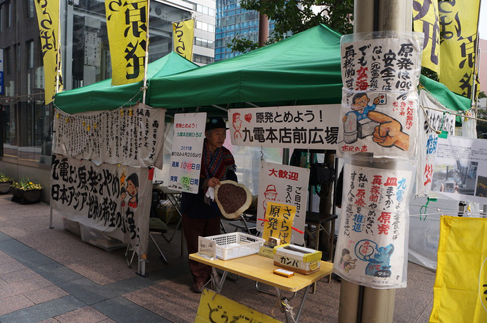The nuclear accident that occurred at Tokyo Electric Power Co.’s (TEPCO) Fukushima Daiichi Nuclear Power Station in the wake of the Great East Japan Earthquake disaster on March 11, 2011 is causing severe radioactive contamination, not only in Fukushima but also in many other areas of Japan. The problems involving nuclear power plants and nuclear substances are threatening people’s lives and their future over an extensive area, and Kyushu is no exception. Experts have pointed out that the antiquated Unit 1 reactor at Genkai Nuclear Power Station in Saga Prefecture may be damaged if it is scrammed and cooled suddenly (see NIT 148 and 149). This reactor became operational in 1975. Unit 3 is a plutonium-thermal (pluthermal) reactor that experienced a leak of radiation into the primary cooling water system at the end of 2010. Local residents have repeatedly demanded a thorough investigation into the cause of the accident and the disclosure of relevant information, but Kyushu Electric Power Co. (KEPCO), the operator of the nuclear plant, has refused to comply with the demand. The Fukushima nuclear accident occurred as this situation was continuing. The anti-nuclear citizens called on the utility company to hold a public hearing on March 31, 2011 and to explain about the radiation leak at the Genkai nuclear power plant in the meeting. However, KEPCO failed to respond to the request by April 20, and the hearing was not held. Since then, the anti-nuclear residents have been staging a round-the-clock sit-in, demanding the shutdown of the nuclear power plant and KEPCO’s sincere response to their request. The result of this was that a “square” was created in front of KEPCO’s main office, only 10 meters (16 steps) from the building. The current situation at the “Square” The “Square,” where men and women of all ages can freely come, go and meet has significance in many ways. 1) It is significant as a place where people express their anti-nuclear views by, for example, participating in signature-collecting campaigns, and other anti-nuclear activities. 2) It is also significant as an information center for distributing leaflets and sending out email reports on the anti-nuclear groups’ activities and efforts. 3) It serves as a café where anti-nuclear citizens can talk with each other and hold discussions with other people who have different views. (Even the former KEPCO President Toshio Manabe came to this café once.) 4) It also serves as a venue for ad-lib music concerts, a stage for performers using a microphone, or pot-luck parties with home-made cooking. Many of the people coming to this Square these days are visitors who are concerned about nuclear power. Participation in Square activities is not limited just to certain members. Anyone interested in nuclear issues can visit the Square and freely take part in the activities. There were occasions when rightist groups and police obstructed the citizens’ peaceful activities in the Square, but the sit-in participants never gave in to this obstruction and marked the 1000-day sit-in in the makeshift tent on January 14, 2014. The citizens are still continuing their activities in the Square today, striving to thwart KEPCO’s resumption of the nuclear plant operation and to keep the memories of the nuclear accident alive in people’s minds. The Square is a place that helps people connect with each other and gain various kinds of capabilities and strengths. The creation of human networks and the enhancement of human power and capabilities are necessary for all people. If you are worried about nuclear power, please come to the Square. The people in the Square are always ready to help you. Please also tell future generations about the current situation at the Square. We need new ties with many more people, and want to gain further human capabilities and power in our efforts to create a nuclear-free society. We have released a booklet to commemorate the 1000th day of our anti-nuclear activities. (Sorry, in Japanese) It contains 100 color photos and detailed explanations on the history of the Square. If you would like copies of this booklet, please email your name, address, telephone number, and the number of booklets you would like to <y-aoyagi@r8.dion.ne.jp>. Click here for articles about other Japanese groups Return to NIT 159 contents |

| CNIC Citizens' Nuclear Information Center Akebonobashi Co-op 2F-B, 8-5 Sumiyoshi-cho, Shinjuku-ku, Tokyo, 162-0065, Japan TEL.03-3357-3800 FAX.03-3357-3801 Map http://cnic.jp/english/ |

